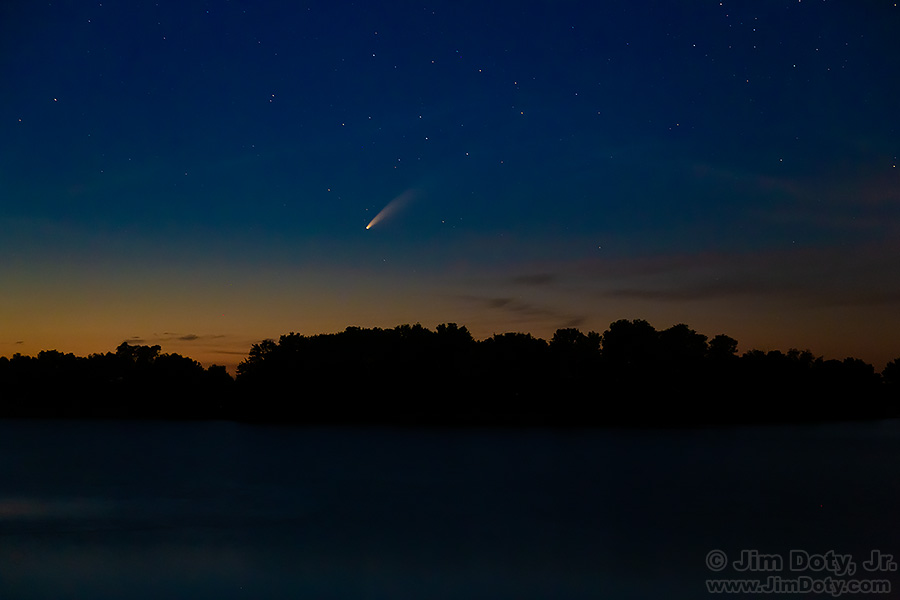
Despite all the hype, Comet Leonard may not be bright enough to see with your naked eyes. Other recent comets have been more visually impressive. Most of the experts say you will need binoculars. The key is to know where to look.
Here’s the word, straight from NASA:
“On Wednesday evening, Dec. 15, 2021, comet Leonard will appear 10 degrees above the southwestern horizon about 30 minutes after sunset at 5:17 p.m. EST, and it will be about 4.5 degrees above the west-southwestern horizon as evening twilight ends at 5:50 p.m. Over the next few evenings, the comet will appear to shift to the left and slightly higher along the horizon each night, but it is expected to begin to appear dimmer as it moves away from Earth.”
You will nead a clear view of the southwest horizon because 10 degrees above the horizon is about the same as the width of your fist at arm’s length. With the bottom of your fist right on the horizon, Comet Leonard will be at the top of your fist. The catch is you probably won’t be able to see it with your naked eyes, so scan the west-southwestern horizon with binoculars about 30 minutes after sunset (5:17 pm local time). The comet will slowly drop toward the horizon over the next 30 minutes and get lost in the horizon murk.
Each night look a little farther west and a little bit higher. Your best night will likely be December 17 since you can use Venus to locate the comet. Again from NASA:
“On Friday evening, Dec. 17, 2021, comet Leonard will appear about 5 degrees below the bright planet, Venus. It may not be easy to see by this time without binoculars or a telescope, but Venus may provide a bright guide for finding the comet. comet Leonard will continue to appear above the horizon at the time evening twilight ends until around January 10, 2022.”
Point your binoculars at Venus and you should see the comet directly below Venus.
To photograph Comet Leonard follow these suggestions.
Camera and Lens Settings
Put your camera on a tripod and point it at the southwest horizon. Start with an ISO of 800 and a lens aperture of f/4. Try shutter speeds in one stop increments of 15, 8, 4, and 2 seconds. If 15 seconds is too dark try 30 seconds. Experiment. Comet Leonard has been unpredictable over the last few days and seems to be dimming as it approaches the sun.
As it gets darker and Comet Leonard gets closer to the horizon you might need to change to higher ISO settings like 1600 and 3200.
Lens Focal Length
The longer the lens focal length you use, the bigger the comet will be, but you will have less sky area and less stars. A shorter focal length will give you more sky and stars but a shorter comet. The photo above was photographed at 70mm so you get less sky but a bigger comet. Experiment with different focal lengths from 70mm to as wide as 24 mm.
If this is your first time doing this I suggest you start with a focal length around 50mm.
Focusing on Infinity
This is your biggest technical challenge. Your camera can’t autofocus on the night sky, and at night it is too dark through your camera’s viewfinder to manually focus.
If your lens isn’t focused on infinity, your stars will be little round blobs instead of points of light. So focusing your lens on infinity is important. This article tells you how to do that.
One simple way to do this is to show up early, focus on the distant horizon, turn off autofocus and don’t touch the focus ring for the rest of the night. Don’t touch the zoom ring either.
Don’t forget, if you are using a zoom lens, if you change the focal length you change the focus point. If you are focused on infinity at 50mm and you zoom to 70mm, the lens is no longer focused on infinity so you will need to refocus.
Links
Full Moon Guide: November – December 2021 – at NASA. “Scroll down to the Detailed Daily Guide”.
Comet Leonard – at Space.com
